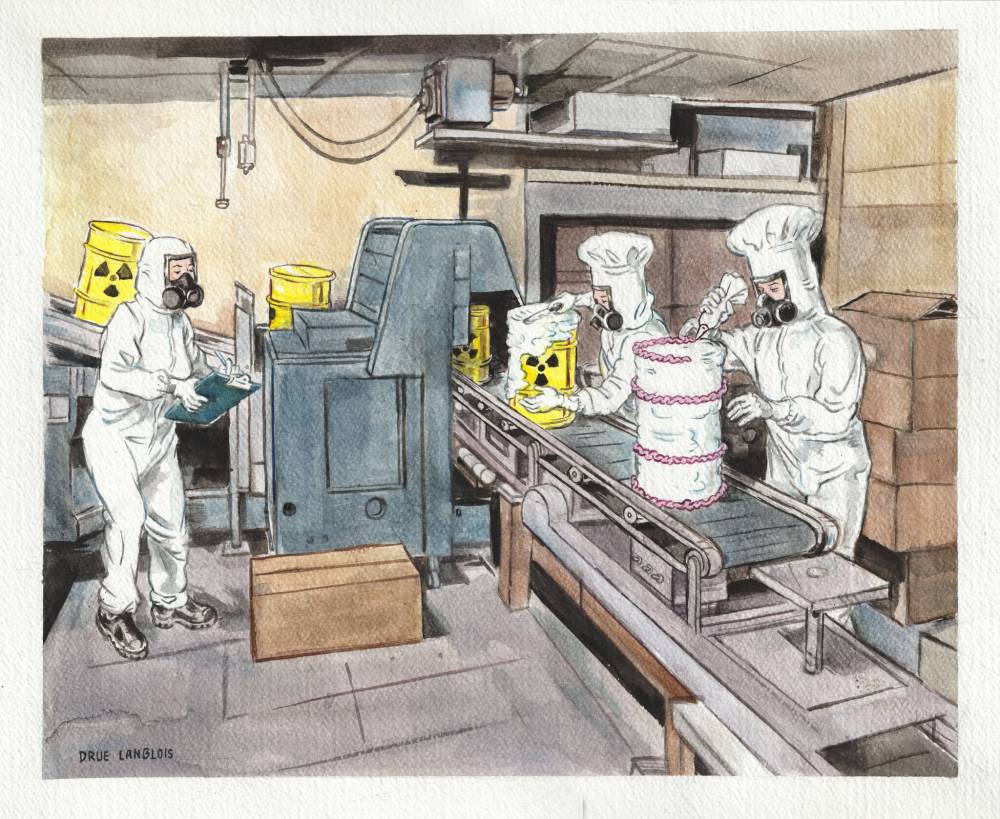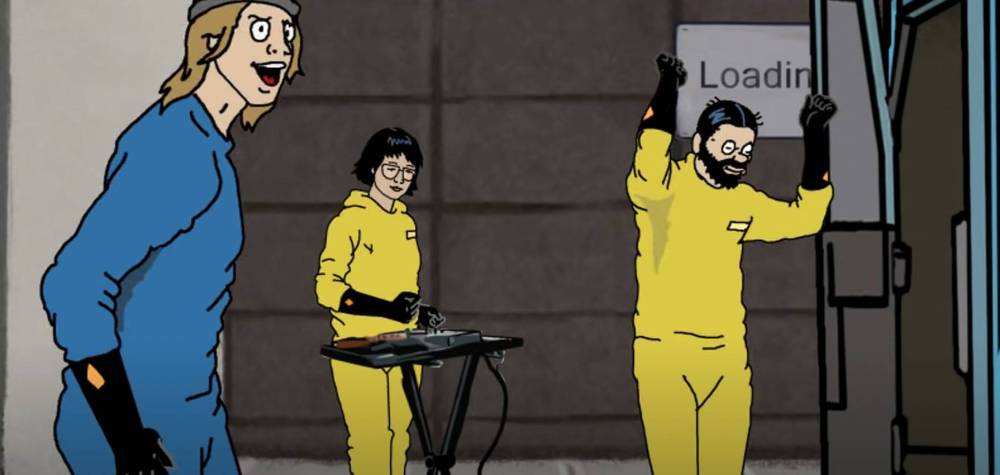Hazardous material
Animated series draws aficionados of the absurd to Royal Art Lodge alum
Advertisement
Read this article for free:
or
Already have an account? Log in here »
To continue reading, please subscribe:
Monthly Digital Subscription
$0 for the first 4 weeks*
- Enjoy unlimited reading on winnipegfreepress.com
- Read the E-Edition, our digital replica newspaper
- Access News Break, our award-winning app
- Play interactive puzzles
*No charge for 4 weeks then price increases to the regular rate of $19.00 plus GST every four weeks. Offer available to new and qualified returning subscribers only. Cancel any time.
Monthly Digital Subscription
$4.75/week*
- Enjoy unlimited reading on winnipegfreepress.com
- Read the E-Edition, our digital replica newspaper
- Access News Break, our award-winning app
- Play interactive puzzles
*Billed as $19 plus GST every four weeks. Cancel any time.
To continue reading, please subscribe:
Add Free Press access to your Brandon Sun subscription for only an additional
$1 for the first 4 weeks*
*Your next subscription payment will increase by $1.00 and you will be charged $16.99 plus GST for four weeks. After four weeks, your payment will increase to $23.99 plus GST every four weeks.
Read unlimited articles for free today:
or
Already have an account? Log in here »
Hey there, time traveller!
This article was published 10/12/2024 (352 days ago), so information in it may no longer be current.
The Royal Art Lodge is dead, long live the Royal Art Lodge.
The now-defunct Winnipeg art collective were young darlings of the Canadian art scene in the ’90s and 2000s. And while it dissolved in 2008, many of its members continue to be the talk of the town and well beyond.
(Marcel Dzama, for instance, counts Beck, Maurice Sendak, Bob Dylan and Spike Jonze as collaborators, helping him to earn splashy profiles in The Guardian and New York Times.)
Drue Langlois is a little different. Make no mistake: the RAL alumnus works very successfully as an artist. However, it’s been almost entirely under the culterati’s radar.
“I’ve written to, like, 12 galleries in the past year, so just nothing — barely a response,” he says with a chuckle.
A nod from the arts establishment would be nice — but does he really need its support? Langlois is behind arguably the most popular indie cartoon ever to emerge from the Prairies: Dudes of Hazmat.
The newest episodes of Dudes of Hazmat première on Samsung’s Animation Plus before becoming free on his YouTube channel. And on that channel alone — which also hosts live-action shorts and music videos with local collaborators such as Dylan Baillie and Sarah Barstead — the show has garnered millions of streams.
His work enjoys a cult following that reverberates in unexpected places across the internet. Scrolling through Instagram or TikTok, it’s not unusual to find another channel has ripped off his content.
“I gotta know what this is from,” reads a comment with nearly 10,000 likes below an Instagram post that’s copped his Shoebody Bop music video for the band Minute Hour. Another reads (sic): “2 things: 1) what a banger 2) how did I landed in this side of the internet again?”
The original full video, with nearly two million streams, depicts an immersion baptism with an unorthodox step: a bop to the head before being plunged into the river. The newly baptized sing along to the Shobody Bop refrain as they float away peacefully.
In a cartoon music video Langlois made for local electronic dance outfit French Class, the band’s leader, Megumi Kimata, and the Dudes of Hazmat are chased by a toxic-waste monster before they settle matters by drop-kicking the monster, lighting him on fire and dancing the night away with a bottle of moonshine.
“The ones that they really got attached to (are) the dropkick ones,” says Langlois of his online fans.
Clearly, it’s not just in the internet’s mediums, but its styles of humour where Langlois has found home.

Drue Langlois photo
The Dudes of Hazmat, created by Drue Langlois, is arguably the most popular indie cartoon to emerge from the Prairies.
A few years ago, millennials coined a snarky retort to what they perceived as out-of-touch behaviour from middle-aged people: “OK, boomer.” But today, much of millennial culture is already seen as old hat, stuck in an era of skinny jeans and mainstream comedy inspired by the likes of Jim Carrey, Saturday Night Live and Jerry Seinfeld. This is what generation Z dismissively calls “millennial core” or “millennial cringe.”
It contrasts with their broadly more absurd humour, forged in social media’s crucible, whose touchpoints are things such as meme “brain rot” (announced as Oxford’s 2024 word of the year), ironic slang and the Adult Swim networks’s Dadaistic animated shows.
Though a gen-Xer, Langlois’ work feels in touch with this zeitgeist. Dudes of Hazmat could easily live as one of the bonkers cartoons produced by Adult Swim.
So how did Langlois go from art world darling to internet meme-lord in a couple of decades?
Langlois says after RAL’s dissolution in 2008, he was looking for a creative change.
“My brother started (in 2008) finding these programs to do animation and they were very straightforward, and then I slowly learned those programs,” says Langlois.
He started posting animations in 2012, mostly as a side project, but they weren’t really doing numbers online.
And then suddenly, around 2019, some members of the military in the United States got attached to a video called Can of Whoop Ass, he says. It became a meme, and his engagement started to take off.
Langlois now has nearly 200,000 YouTube subscribers, and his fans come from all over the place. He finds it refreshing to not just make work pitched for the sort of crowd who flock to gallery openings.
“I want to reach other people because I believe in goodness and humanity, but I guess I’m promoting violence,” he says.

Drue Langlois
The music video Toxic Waste Chase sees the Dudes of Hazmat join with French Class band leader Megumi Kimata.
“That’s not good.”
Langlois is being self-deprecating. The violence in his cartoons is, well, cartoonish and mostly mild. A similar style is evident in his drawings, which he posts to Instagram and feel like picture books aimed at adults: whimsical, pretty and just a little menacing.
When it comes to his work’s darker and more absurd stuff, he explains it as an effort to work through the strange logic and impulses, “the symbolic form of everyday life,” manifest in dreams.
Suddenly it seems easier to see the throughline between his current work and the Royal Art Lodge. The collective’s cute but macabre collaborations — with each artist responding spontaneously to what the previous artist had put on the page — shared something with the Freudian automatists who encouraged artists to work freely from the unconscious.
It’s tempting to pursue this line further with Langlois, but he seems too unpretentious to spend long on such art school theorizing. He’s busy entertaining the online masses with work that’s managed, somehow, to fuse a certain highbrow surrealist sensibility with slightly adolescent, popular appeal.
Interested in exploring the current work of Royal Art Lodge alumni? Marcel Dzama opened his solo show, Ghosts of Canoe Lake, at Winnipeg’s Plug In Institute of Contemporary Art in November, while other former Art Lodgers Michel Dumontier and Neil Farber host a workshop with Diana Thorneycroft at ArtLab today.
conrad.sweatman@freepress.mb.ca

Conrad Sweatman is an arts reporter and feature writer. Before joining the Free Press full-time in 2024, he worked in the U.K. and Canadian cultural sectors, freelanced for outlets including The Walrus, VICE and Prairie Fire. Read more about Conrad.
Our newsroom depends on a growing audience of readers to power our journalism. If you are not a paid reader, please consider becoming a subscriber.
Our newsroom depends on its audience of readers to power our journalism. Thank you for your support.




